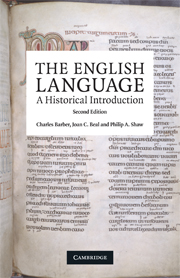Book contents
- Frontmatter
- Contents
- List of figures
- Preface to the second edition
- Preface to the first edition
- Map showing the counties of England
- 1 What is language?
- 2 The flux of language
- 3 The Indo-European languages
- 4 The Germanic languages
- 5 Old English
- 6 Norsemen and Normans
- 7 Middle English
- 8 Early Modern English
- 9 Late Modern English
- 10 English as a world language
- 11 English today and tomorrow
- Notes and suggestions for further reading
- Bibliography
- Index
6 - Norsemen and Normans
- Frontmatter
- Contents
- List of figures
- Preface to the second edition
- Preface to the first edition
- Map showing the counties of England
- 1 What is language?
- 2 The flux of language
- 3 The Indo-European languages
- 4 The Germanic languages
- 5 Old English
- 6 Norsemen and Normans
- 7 Middle English
- 8 Early Modern English
- 9 Late Modern English
- 10 English as a world language
- 11 English today and tomorrow
- Notes and suggestions for further reading
- Bibliography
- Index
Summary
During the later part of the Old English period, two different groups of non-English speakers invaded the country. Both groups were Scandinavian in origin, but whereas the first had retained its Scandinavian speech, the second had settled in northern France and become French-speaking. Both of their languages, Old Norse (ON) and Old French (OF), had a considerable influence on English.
The Vikings in England
The harrying of Europe by the Scandinavian Vikings, which took place between about 750 and 1050, was the last phase of the expansion of the early Germanic peoples. Its basic cause was perhaps overpopulation in a region of poor natural resources, but there were other contributory causes. The custom of leaving the inheritance to the eldest son meant that there were always younger sons wanting to carve out inheritances for themselves. Political conflicts drove many noblemen into exile. And then, in the late eighth century, Charlemagne destroyed the power of the Frisians, who had hitherto been the greatest maritime power of north-western Europe, and thereby left open the sea-route southward for the Vikings. At about the same date, the ancient craft of boat-building in Scandinavia reached the stage at which it could produce the magnificent ocean-going sailing-ships which served the Vikings for trade, piracy and colonization.
The Vikings were great traders, but it is for their more predatory activities that they are most remembered. Their attacks varied from piratical expeditions by single ships to the invasion of a country by sizeable fleets and armies.
- Type
- Chapter
- Information
- The English LanguageA Historical Introduction, pp. 137 - 160Publisher: Cambridge University PressPrint publication year: 2009



